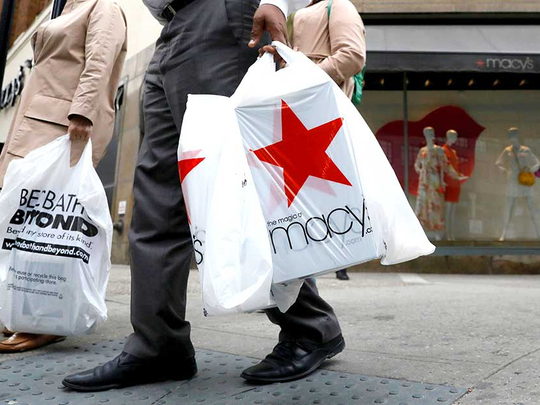
WASHINGTON
The US economy slowed less sharply in the first quarter than initially estimated due to unexpectedly higher consumer spending and a jump in exports, beating expectations and providing a slightly more encouraging outlook for growth this year.
Gross domestic product increased at a 1.4 per cent annual rate instead of the 1.2 per cent pace reported last month, the Commerce Department said in its final assessment for the period on Thursday.
It was still the worst performance since the second quarter of last year. Economists polled by Reuters had expected GDP growth to be unrevised at a 1.2 per cent rate.
The economy tends to underperform in the first quarter relative to the rest of the year due to perennial issues with the calculation of the data. The government has said it is working to resolve those issues.
US stocks were mixed after the biggest rally in two months, as banks surged amid a massive increase share buy-backs to offset renewed weakness in technology shares. The euro and pound strengthened on expectations for hawkish central bank policy.
The S&P 500 Index’s two largest cohorts, banks and tech shares, battled to a standstill, leaving the equity benchmark little changed. Treasuries weakened anew, pushing 10-year rates above 2.28 per cent. The euro hit the highest level in more than a year even after officials walked back hawkish comments from Mario Draghi. Sterling’s seventh straight gain is the longest since 2015 as the UK central bank chief has been even more explicit about tightening.
The US dollar briefly edged up after the release of the data before retracing earlier losses against a basket of currencies.
First-quarter economic growth was boosted by an upward revision to consumer spending, which accounts for more than two-thirds of US economic activity. Consumer spending rose at a 1.1 per cent rate, the weakest reading since the second quarter of 2013 but almost double the 0.6 per cent reported last month.
“The main surprise in Q1 was a larger than expected upward revision to consumption,” said Ted Wieseman, an economist at Morgan Stanley.
Despite the upward revision to GDP, the Trump administration’s stated target of swiftly boosting annual US economic growth to 3 per cent remains a challenge.
A sustained average growth rate of 3 per cent has not been achieved in the United States since the 1990s. The US economy has grown an average 2 per cent since 2000 and it expanded only 1.6 per cent in 2016, which was the weakest growth in five years.
President Donald Trump’s economic program of tax cuts, regulatory rollbacks and infrastructure spending has yet to get off the ground five months into his presidency.
Details of the White House’s tax plan remain sparse as Trump advisers attempt to win over fiscally conservative Republicans in Congress who want any changes to ultimately be revenue-neutral.
Initial signs that economic growth re-accelerated sharply in the second quarter have also faltered in the face of recent disappointing data on retail sales, manufacturing production and inflation. Housing data has also been mixed.
The Atlanta Federal Reserve currently forecasts the economy to grow at an annualised rate of 2.9 per cent in the second quarter.
Labour market still strong
Other data on Thursday showed the job market was still flashing a green light.
The Labour Department reported that the number of Americans filing for unemployment benefits last week rose slightly, but the underlying trend remained consistent with a tight Labour market. The unemployment rate fell to a 16-year low in May.
US exporters also flexed more muscle in the first quarter.
Exports for the period were revised to show a 7.0 per cent rate of growth from the previously reported 5.8 per cent. Exports in the fourth quarter fell at a rate of 4.5 per cent.
— Reuters












